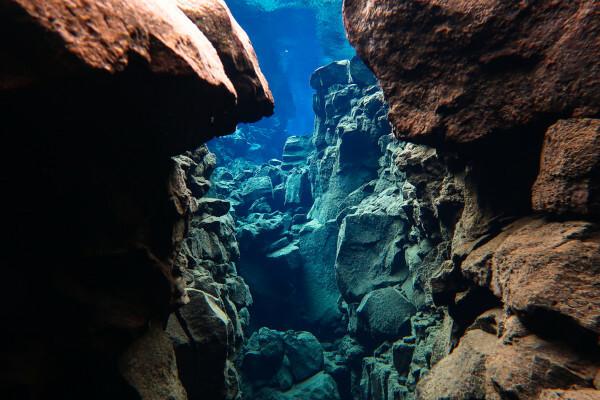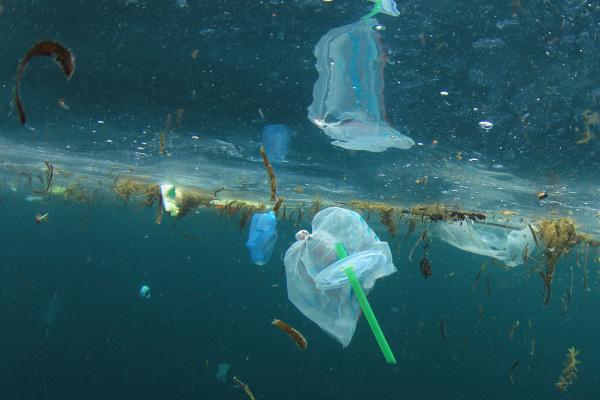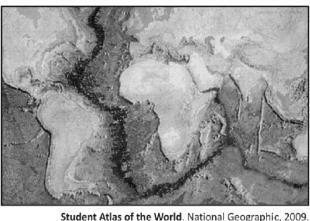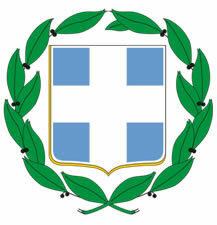O Atlantic Ocean is a set of waters that covers 85 million km² of the earth's surface and bathes the east of the American continent and the west coast of Europe and Africa. it is about the second largest ocean on the planet and the one that reaches the largest number of countries.
É one of the busiest waterways in the world, considering that it connects areas of intense economic dynamism. One of its biggest environmental problems today is pollution from plastic and microplastic.
Read too: What are tides?
What are the characteristics of the Atlantic Ocean?
The Atlantic is a set of waters that covers about 16.7% of the terrestrial surface, the equivalent of 85.13 million square kilometers. It is the second largest ocean on the planet, behind only the Pacific. It holds a volume of 310.4 million km³ of water, almost half of the first place.
the Atlantic is an ocean considerably narrow compared to the Pacific, as we can see in the map above, but it has a wide longitudinal extension and is in contact with everyone else oceans that cover the planet: Arctic, Pacific, Indian and Antarctic.
In its formation, we find a series of gulfs, bays, straits and seas. Among these, the following stand out:
Caribbean Sea
labrador sea
Mediterranean Sea
Black Sea
Norwegian Sea
Greenland Sea
sea of scotland
North Sea
Baltic Sea
Irish Sea
Do not stop now... There's more after the advertising ;)
Atlantic ocean geography
the Atlantic extends from 60º N parallel to 60º S parallel, which mark, respectively, the transition to ocean waters Arctic and Antarctic. In this is the Drake Passage, located in the extreme south of America and which indicates the separation of the continents American and Antarctic. Atlantic waters are commonly divided between North Atlantic and South Atlantic, depending on the arrangement of the hemispheres.
As it covers an extensive longitudinal strip, the Atlantic bathes almost all climatic zones on the planet, with the exception of the polar zones. This means that its waters are subject to different pressure and atmospheric circulation systems. Phenomena such as tropical and extratropical storms and hurricanes they originate in the waters closest to the equator. Some of the training areas are the Gulf of Mexico, in North America, and also those close to Cape Verde, in northwestern Africa.

The main form of the Atlantic oceanic relief is the dorsal Mid-Atlantic, a mountain range that is 1600 meters wide and extends, from north to south, in the center of the ocean floor. Its origin refers to the process of opening and formation of the Atlantic, being, therefore, composed of volcanic rocks. The elevations can reach up to five thousand meters, and, in certain stretches, it protrudes through the surface and gives rise to volcanic islands.
Following the dorsal are the abyssal plains, where there may be hills that represent inactive volcanoes, the continental slope and, finally, the continental shelf. In meeting areas of tectonic plates and failures, are the ocean trenches. One of these formations is the lowest point in the Atlantic, named Milwalkee depression, in the Puerto Rico trench, at 8,605 meters deep.
See too: What are the soil formation factors?
How important is the Atlantic Ocean?
The Atlantic Ocean holds great economic importance, which is due both to its spatial distribution and to the natural resources found in its waters and on the continental shelf. Firstly, this ocean separates large continents, where ports are highly installed. and that promote the flow of a series of essential products for trade International. The Atlantic becomes, therefore, a sea route heavily used, being one of the oceans with the most intense vessel traffic.
THE fishing it is an important activity developed for both subsistence and commercial purposes. The intensification of this modality in particular has been quite harmful to the maintenance of several species of fish and, especially, whales.
Reservations of Petroleum and natural gas they are also found in the Gulf of Mexico, the Caribbean Sea, the North Sea and along the Brazilian coast. Another prominent sector in the economy is the tourism, held on the numerous beaches along its coastline and on the various paradisiacal islands, involving activities such as visitation, cruises and diving.

Finally, a gamma ofecosystems marine is identified in the Atlantic Ocean, whose waters serve as habitat for a vast biodiversity, which includes plants and animals that live both in shallow waters and at great depths, such as:
sharks
dolphins
whales
turtles
birds
molluscs
sea lions
Atlantic Ocean Environmental Problems
The Atlantic Ocean faces several environmental problems caused directly and indirectly by human action. One of the biggest ones is the accumulation of huge amounts of plastic and microplastic. A recent study, published in the scientific journal nature, estimates that the amount of this material present today in the Atlantic is up to 10 times greater than what was believed a few years ago, accounting for 200 million tons.
In general, the urban and industrial waste and waste disposal (which can include highly toxic substances) untreated poses a major threat to water quality and biodiversity. It is noteworthy that the garbage can come from both inhabited areas in coastal areas and from vessels that navigate the Atlantic seas daily.

the Atlantic also suffers withspills of oil by tankers and areas where the extraction itself takes place, causing damage such as the death of marine animals and algae and the destruction of their natural habitats, and also causing direct damage to populations that take their livelihood from these waters.
See too: Consequences of anthropic actions on the environment
Which continents and countries are bordered by the Atlantic Ocean?
The Atlantic is the ocean that covers the largest number of countries and territories, totaling 111,866 km of coastline. Its waters reach part of the coast and islands belonging to three continents, namely:
America (North America, Central America and South America)
Europe
Africa
Check out which are the main countries of each of the continents bathed by the Atlantic:
Africa
South Africa |
Gabon |
Liberia |
Congo |
Angola |
Gambia |
Mauritania |
Western Sahara |
benin |
Ghana |
Morocco |
Sao Tome and Principe |
Cape Green |
guinea |
Namibia |
Senegal |
Cameroon |
Guinea Bissau |
Nigeria |
Sierra Leone |
Costa do Marfim |
Equatorial Guinea |
Democratic Republic of Congo |
Togo |
-
America
North America
Canada |
U.S |
Greenland |
Mexico |
Central America and the Caribbean
Antigua and Barbuda |
Cuba |
Honduras |
Puerto Rico |
Bahamas |
Dominica |
Jamaica |
Dominican Republic |
Barbados |
Grenade |
Nicaragua |
Saint Kitts and Nevis |
Belize |
Guatemala |
Panama |
Trinidad and Tobago |
Costa Rica |
Haiti |
Saint Lucia |
Saint Vincent and the Grenadines |
South America
Argentina |
Colombia |
Suriname |
Brazil |
Guyana |
Uruguay |
Chile |
French Guiana |
Venezuela |
Europe
Albania |
Slovenia |
Italy |
Netherlands |
Germany |
Spain |
Latvia |
Poland |
Belgium |
Finland |
Lithuania |
Portugal |
Bosnia Herzegovina |
France |
Malta |
UK |
Cyprus |
Greece |
monaco |
Russia |
Croatia |
Ireland |
Montenegro |
Sweden |
Denmark |
Iceland |
Norway |
Turkey |
Curiosities about the Atlantic Ocean
Its name derives from Atlas, a titan of Greek mythology who became known as the lord of the waters.
Until 2000, the portion of water below the parallel of 60º S was part of the Atlantic Ocean. A new delimitation by the International Hydrographic Organization defined that this area would form, from then on, another ocean, the Antarctic.
The Caribbean Sea is the largest of the seas that make up the Atlantic, covering an area of 2.75 million km². Next is the Mediterranean Sea, with 2.51 million km².
The famous is on the Atlantic Bermuda Triangle, an area known for the mysterious disappearance of a series of ships and planes, as well as being the focus of problems in electronic devices. It was and still is the subject of many works of science fiction. Researchers believe that the explanation for such phenomena lies in the terrestrial magnetic field.
solved exercises
Question 1 - The Atlantic Ocean is the second largest set of waters in the terrestrial hydrosphere. It bathes important economic areas of the American, European and African continents, receiving, as a result, an intense daily traffic of vessels.
Read the statements below about this ocean and tick the incorrect one.
A) It has a large longitudinal extension and is in contact with all the other four oceans.
B) In areas close to the equator line, large tropical storms that hit Central American countries are generated.
C) One of its main environmental problems is plastic pollution.
D) The deepest ocean depth in the world is located in Puerto Rico: the Mariana Trenches, which reach almost 11 thousand meters below the surface.
Resolution
Alternative D. The Marina Trenches are located in the Pacific Ocean, located near the islands of the same name.
Question 2 - (Fuvest 2015) Note the figure, with an emphasis on the Atlantic ridge.

Please rate the following statements:
I. According to plate tectonics theory, the African and American continents continue to drift apart.
II. The presence of younger rocks close to the Atlantic ridge compared to older rocks, in places more distant, is indicative of the existence of boundaries between divergent tectonic plates in the floor oceanic.
III. Similarities between rocks and fossils found on continents that are now separated by the Atlantic Ocean are considered evidence that these continents were once united.
IV. The formation of the Atlantic dorsal mountain range resulted from a clash between the North American and African tectonic plates.
What is stated in:
A) I, II and III only.
B) I, II and IV only.
C) II, III and IV only.
D) I, III and IV only.
E) I, II, III and IV.
Resolution
Alternative A. Only statement IV is incorrect, since the Atlantic ridge is the result of the process of moving away from the tectonic plates. In contact areas, ocean trenches are produced.



